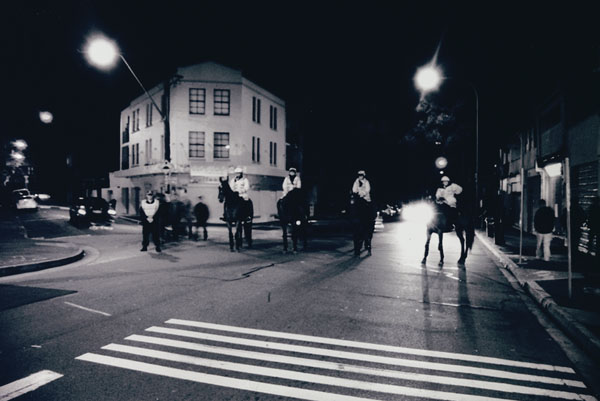
The Xstrata selection could be characterised as two-way art: remote area traditional and urban political. But which is the more contemporary, which is the more inventive, which is the more relevant? This year's winner, Genevieve Grieves constructs an installation of five panels called 'Picturing the old people'. Each panel presents a camera's eye view from within a turn-of-the-century still photographer's studio. Although standing stock-still, this camera eye is a digital video. Dramas slowly unfold in the panels as Grieves tells a subtle story of survival amid superficially benign but nonetheless insidious cultural intervention. Cultural tragedy, she suggests, can be found not only in violence but also in middle-class aspirations. This is never a single straightforward narrative. Numerous issues that persist within contemporary society for Aboriginal people are subtly and hauntingly evoked, but with an ambivalence that leaves the judgement up to us.
In contrast, Yhonnie Scarce adopts a more explicit politics. Scarce's points have been often made by others, notably by Fiona Foley, but not in Scarce's chosen medium: glass. Here, delicately-blown glass sculptures of bush fruits are variously chained, hung by the neck, placed into little coffins, and wrapped in a British flag. This is more the in-your-face style we have come to associate with urban Indigenous artists. Adam Hill is known for his city-slick paintings dealing with Indigenous and environmental issues. A token example of his critique of mining is courageously included in spite of the award's sponsorship. But Hill's main contribution is a set of tough black and white photographs of Redfern. As an urban Indigenous enclave, Redfern personifies political tension. We learn how powerful this tension is when Hill's photograph of Redfern station, objectively resembling every other suburban railway station, still seems to seethe with an ominous energy.
In contrast to these works, the remote area artists seem entrenched in a far distant past. But are they? Wanyubi Marika's bark paintings are the product of an unbroken tradition. But, bark painting itself is probably a relatively recent transfer of sand and body painting techniques to a commodifiable medium. And Marika proves that it is still developing. While saltwater creation stories are passed on according to timeless protocols, a technical extension of 'rarrk' contributes here to their actual portrayal. Echoing the concentric rhythms and waveforms of paddles striking the water, white crosshatch on white in his pictures suggests a transparent fading world. Irenie Ngalinba demonstrates a different adaptation of 'rarrk' as she animates the gush of river over rock in her pictures with alternating flows of diagonals. In recovering traditional basketweaving skills, Abe Muriata simultaneously experiments with making baskets out of non-organic industrial materials such as wire. A similar line of experimentation was followed by Lorraine Conolly-Northey in last year's Xstrata. Where this is leading in Muriata's case is not yet apparent, but his lawyer vine weaving is masterful.
The most visually subtle of the remote-area women artists is Phyllis Ningarmara who chooses to be inspired by the multicoloured pebbles brought to her country by floodwaters called 'Gerran' and uses only natural earth pigments. These pebbles are represented simply as circular shapes of colour surrounded by a ring of colour against a background of another colour, and, despite the catalogue's explanation that the pictures owe their brilliance to the natural crushed ochre of the region, I would argue that their colour effects are almost entirely the result of clever orchestration.
All in all, this is a rich and wonderful exhibition, but sadly misnamed. How much longer are supremely accomplished artists such as 63-year-old Phyllis Ningarmara, or Wanyubi Marika with a high degree of celebrity and an internet presence as long as your arm, or Adam Hill with numerous solo and group shows to his credit, going to be considered 'emerging'? The Xstrata Award is a great initiative, but it should be called the award for Recent Developments in Indigenous Art.












